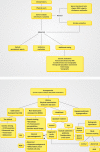An update on the clinical assessment of the infertile male. [corrected]
- PMID: 21655766
- PMCID: PMC3093801
- DOI: 10.1590/s1807-59322011000400026
An update on the clinical assessment of the infertile male. [corrected]
Erratum in
- Clinics (Sao Paulo). 2012;67(2):203
Abstract
Male infertility is directly or indirectly responsible for 60% of cases involving reproductive-age couples with fertility-related issues. Nevertheless, the evaluation of male infertility is often underestimated or postponed. A coordinated evaluation of the infertile male using standardized procedures improves both diagnostic precision and the results of subsequent management in terms of effectiveness, risk and costs. Recent advances in assisted reproductive techniques (ART) have made it possible to identify and overcome previously untreatable causes of male infertility. To properly utilize the available techniques and improve clinical results, it is of the utmost importance that patients are adequately diagnosed and evaluated. Ideally, this initial assessment should also be affordable and accessible. We describe the main aspects of male infertility evaluation in a practical manner to provide information on the judicious use of available diagnostic tools and to better determine the etiology of the most adequate treatment for the existing condition.
Figures




References
-
- Vital and Health Statistics, series 23, no. 26, CDC. Available from: http://www.cdc.gov.
-
- Kamel RM. Management of the infertile couple: an evidence-based protocol. Reprod Biol Endocrinol. 2010;8:21–8. 10.1186/1477-7827-8-21 - DOI - PMC - PubMed
-
- World Health Organization: Report of the meeting on the prevention of infertility at the primary health care level. 1984. WHO, Geneva 1983, WHO/ MCH/
-
- Cates W, Farley TM, Rowe PJ. Worlwide patterns of infertility: is Africa different. Lancet. 1985;2:596–8. 10.1016/S0140-6736(85)90594-X - DOI - PubMed
-
- Zargar AH, Wani AI, Masoodi SR, Laway BA, Salahuddin M. Epidemiologic and etiologic aspects of primary infertility in the Kashimir region of India. Fertil Steril. 1997;68:637–43. 10.1016/S0015-0282(97)00269-0 - DOI - PubMed
Publication types
MeSH terms
LinkOut - more resources
Full Text Sources
Medical

